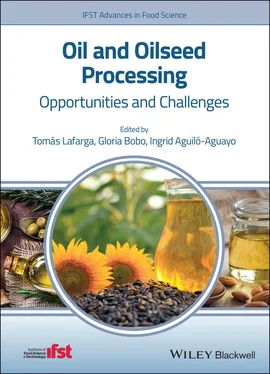1.2.1 Copra and Coconut Oil
Coconut oil is obtained from the fruit of the coconut palm ( Cocos nucifera L.), a tropical plant normally utilized for edible and non‐edible purposes. Two major types of oil can be obtained from coconut: (i) coconut or copra oil, which is obtained from the dried coconut flesh, also known as copra, and (ii) virgin coconut oil, obtained from fresh coconut flesh (Zuknik et al. 2016). Copra oil can be found either unrefined or refined, bleached, and deodorized (Kumar and Krishna 2015).
As a portable source of water (and food), coconuts played an important role in the ability of humans to voyage and colonize regions throughout the tropics (Gunn et al. 2011). Currently, coconut is an important crop in tropical countries where it plays an important role in diets and livelihoods (MacDonald et al. 2018). A large number of food products containing coconut oil have been launched into the market during recent years ( Table 1.1).
Besides being used for frying or as an ingredient in baked goods, coconut oil is currently used for pharmaceutical and cosmetic applications, among others (Kumar and Krishna 2015). Over 12.30 Mha of coconut are currently planted across 89 tropical countries, mainly in Asia (Gunn et al. 2011) – Figure 1.1. Coconut plantations can now be found on practically every tropical and sub‐tropical coastline worldwide, distributed mainly in coastal regions between 20°N and 20°S (Ramanatha Rao et al. 2005). Coconuts are even cultivated far from the coast in many regions with adequate rainfall and altitude (Foale 2005). Over 95% of the farmers who grow coconuts are smallholders tending less than four hectares and lack the resources to invest in technologies that would improve production yields (Batugal et al. 2005). However, production and consumption of coconut oil is expected to increase in coming years and production of virgin coconut oil shows potential for improving coconut farm incomes by five to eightfold over traditional copra production (Bawalan and Chapman 2006).
Table 1.1 Foods manufactured using vegetable (and microalgal) oils.
Source: Data accessed on June 7, 2019 from MINTEL, available at http://www.mintel.com.
| Product |
Brand |
Company |
Country of commercialization |
Oil(s) used |
| Sour cream and onion flavored potato snack |
Pringles |
Pringles, USA |
Argentina |
Cottonseed and coconut oil |
| Roasted and salted peanuts |
Pami |
Pami, Greece |
Croatia |
Cottonseed and sunflower oil |
| Corn “tostadas” |
Mamá Lycha |
Productos Mamá Lycha, USA |
Canada |
Cottonseed, palm, and/or soybean oil |
| Chocolate cake with chocolate topping |
Betty Crocker Mug Treats |
General Mills, USA |
Saudi Arabia |
Cottonseed, palm, sunflower, and rapeseed oil |
| Tomato soup |
Campbell's Soup at Hand |
Campbell, Canada |
Canada |
Canola, corn, cottonseed, and or/soybean oil |
| Hazelnut cream with cocoa and breadsticks |
Nut Bari |
DKC Grup Gida San, Turkey |
Turkey |
Sunflower, cottonseed, and palm oil |
| Spicy vegetable tajine with bulgur, spelt, and raisins |
Carrefour Veggie |
Carrefour, France |
Spain |
Cottonseed and extra virgin olive oil |
| Breakfast cereals |
Kellogg's Froot Loops |
Kellogg Sales, USA |
USA |
Coconut, soybean, and cottonseed oil |
| Cookie covered almonds |
7‐Select |
7‐Eleven, USA |
USA |
Canola, cottonseed, palm kernel, and/or peanut oil |
| Apple pie |
Royal Classic Dutch |
De Specialiteitenbakkerij, the Netherlands |
Switzerland |
Cottonseed, rapeseed, and sunflower oil |
| Rice mini squares |
Kellogg's Rice Krispies Treats Mini Squares |
Kellogg Sales, USA |
USA |
Soybean and palm oil |
| Sweet kale salad |
Eat Smart Salad Shake Ups |
Apio, USA |
USA |
Canola, soybean, and sunflower oil |
| Mr Kipling lemon whirls |
Mr Kipling |
Premier Foods, Ireland |
Ireland |
Rapeseed and palm oil |
| Cookies drizzled in chocolate |
Bake Shop Bites |
Cookies United, USA |
Puerto Rico |
Palm kernel oil, hydrogenated palm oil, and soybean oil |
| Special bread tapas biscuits |
Quely |
Quely, Spain |
Spain |
Sunflower and olive oil |
| Taralli biscuits |
Continental Taralli Biscuits |
Continental Taralli Biscuits, Australia |
Australia |
Olive oil |
| Quinoa salad |
Pur |
PUR Bio Feinkost Manufaktur – Heinz Gierze, Germany |
Germany |
Sunflower and olive oil |
| Tuna salad |
The Yummy Tummy Co, |
The Yummy Tummy Company, UK |
UK |
Olive oil |
| Artichoke pesto |
Casa de la Torre |
Converfrut, Argentina |
Argentina |
Olive oil |
| Infant formula |
Enfamil Neuro Pro EnfaCare |
Mead Johnson, USA |
USA |
Sunflower, soybean, coconut, and Schizochytrium sp. oil |
| Apple drink |
Life Mix |
W Pesquisa, Tecnologia e Indústria de Alimentos, Brazil |
Brazil |
Schizochytrium sp. oil |
| Evaporated milk |
Laive Niños |
Laive, Peru |
Peru |
Mortierella alpine and Schizochytrium sp. oil |
Production of coconut oil during 2014 was estimated as 3.10 Mt (UN 2019). During the period 2018/2019, coconut oil production was reported to be 3.63 Mt (USDA 2019). Approximately 2.70 Mt of coconut oil were produced in Asia, representing approximately 88.4% of the total production. Largest coconut oil producers are the Philippines, Indonesia, and India with 1.10, 0.91, and 0.39 Mt, respectively. The Philippines and Indonesia are also the biggest coconut exporters with approximately 0.75 and 0.60 Mt of coconut oil exported during 2016, respectively. Moreover, the US and the Netherlands are the major coconut oil importers followed by Malaysia and Germany with approximately 0.51, 0.34, 0.15, and 0.15 Mt of coconut oil imported during 2017. Global copra production is expected to increase by 2%, mainly due to expanding coconut plantations in Vietnam and improving yields in the Philippines (USDA 2017).

Figure 1.1 World production of palm fruit, olives, and most economically important oilseeds. Values represent tonnes produced during 2017.
Source: Data accessed on April 8, 2019 from FAOSTAT, the Food and Agriculture Organization Corporate Statistical Database, available at http://www.fao.org/faostat.
1.2.2 Cottonseeds and Cottonseed Oil
Cotton, which is obtained from the cotton plants of the genus Gossypium in the family Malvaceae , is a profit crop for over 20 M farmers in developing countries, mainly cultivated to meet the basic requirements for cotton fabrics (Saxena et al. 2011). Cottonseed is a valuable by‐product of the cotton plant: for every 1 kg of cotton fiber, 1.65 kg of cottonseeds are produced (Saxena et al. 2011). The cottonseed is used to produce oil, mainly for human consumption, and oilseed cake for animal feed. Cottonseed oil fits within the previously mentioned group of plants that are not grown for oil production, and where oil can be considered as a by‐product. However, besides being a “by‐product,” cottonseed oil dominated the US vegetable oil market for almost 100 years (O'Brien et al. 2005). Table 1.1lists some products containing cottonseed oil that were recently launched into the market.
Читать дальше













